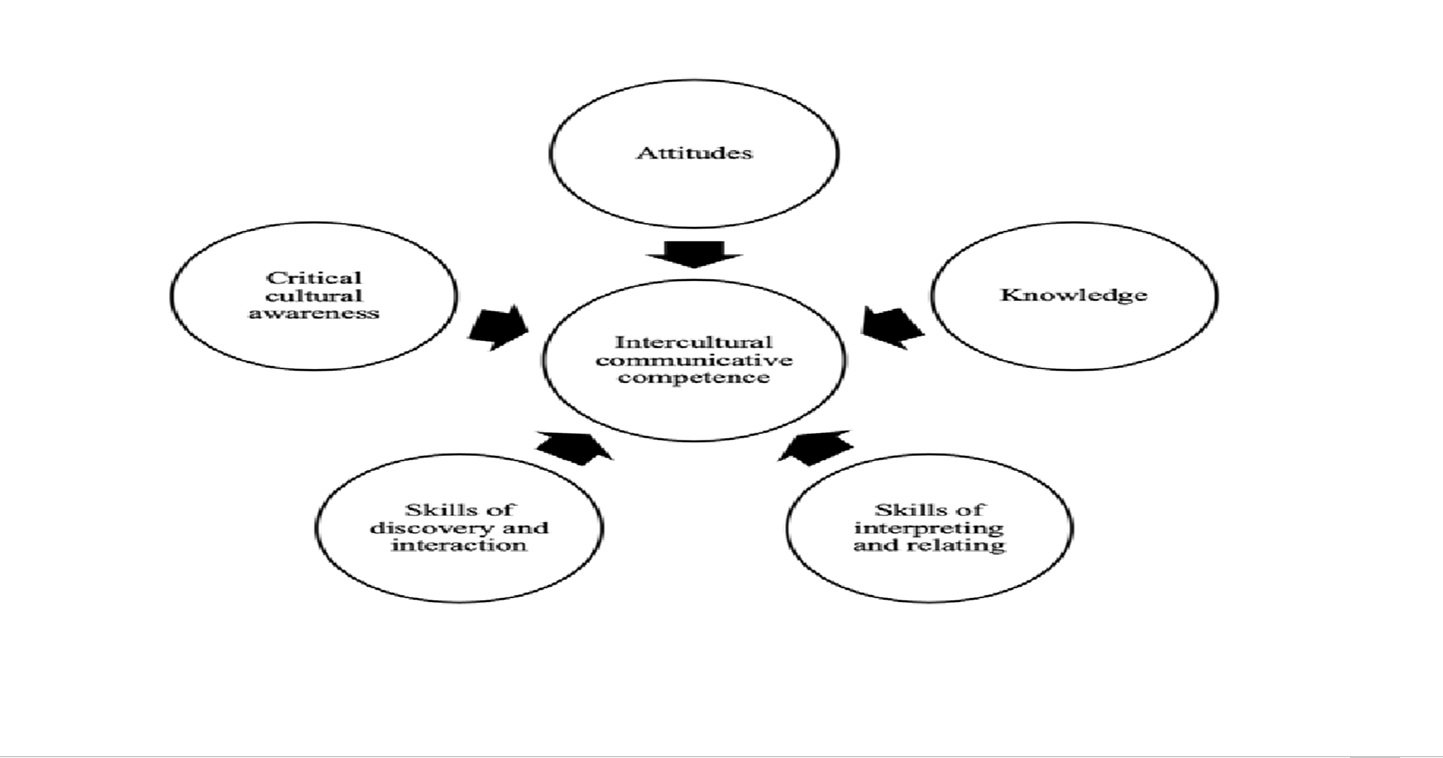Literature Based-Communication in Enhancing EFL Students' Intercultural Awareness through Implementing ICC Model
DOI:
https://doi.org/10.21271/zjhs.28.SpA.24Keywords:
ICC model, intercultural awareness, literature based- communication, EFL student.Abstract
This study investigates the role of teaching literature based-communication in enhancing EFL students’ intercultural awareness through applying Byram’s model of ICC (1997) and the revised version (2020). The study is an empirical with two random groups, control (CG) and experimental group (EG). It aims at examining literature based-communication in enhancing EFL students' intercultural awareness and also aims at detecting the difference between the control and experimental groups' (five element factors). For data collection, a pre-post-test is used. EG received the ICC model and various teaching strategies, while CG is taught traditionally. 2 groups are exposed to the same teaching materials. The participants are 60 second-year English students (30 CG and 30 EG) of English department. The mean score, SD, t-test, and p-value are conducted. The progress is in EG’s post-test compared to the results of CG. The huge progress in five element factors is in the EG’s post-test compared to the results of CG as there is a significant difference of EG post-test in favor of ICC in enhancing intercultural awareness to which the EG was exposed to during the experiment.
References
- Aguilar, M. J. C. (2008). "Dealing with intercultural communicative competence in the foreign language dassroom," in Intercultural language use and language learning,eds E. A. Soler and P. S. Jordà (Cham: Springer), 59-78.
- Allen, T. J. (2021). Exploring Students' Perceptions about Intercultural Communication Education: Rethinking the Design and Facilitation of a Course in Japan. Intercultural Communication Education, 4, 213-233.
- Anastasia, A. & Urbina, S. (1996). Psychological Testing (7thed). New York, Prentice Hall.
- Barnett, A. M. (1989). More than Meets the Eye: Foreign Language Reading. Englewood Cliffs, New Jersey: Prentice Hall Regents.
- Barnett, G. A., and Lee. M. (2007). "Issues in intercultural communication research”, in Handbook of international and intercultural communication, ed. W. B Gudykunst (Thousand Oaks, CA: Sage).
- Bennett, M. J. (1991). "Towards ethnorelativism”: A developmental model of intercultural sensitivity [A] in Cross-cultural interpersonal communication [C). ed. R. M. Paige (Newbury Park, CA: Sage).
- Byram, M. (1997). Teaching and assessing intercultural communicative competence. Clevedon: Multilingual Matters Ltd.
- Byram, M. (2020). Teaching and Assessing Intercultural Communicative Competence Revisited. Multilingual Matters.
- Byram, M., and Wagner, M. (2018). Making a difference: Language teaching for intercultural and international dialogue. Foreign Lang. Ann. 51,5-13.
- Chen, G. M., and Starosta, W. J. (1996). Foundations of intercultural communication. Boston, MA: Allyn & Bacon.
- Chen, G. M., and Starosta, W. (1998). A review of the concept of intercultural awareness. Hum. Commun. Res. 2, 27-54.
- Collie, J., & Slater, S. (1987). Literature in the language classroom. Cambridge: Cambridge University Press.
- Coperias-Aguilar, M. J. (2002). Intercultural Communicative Competence: A Step beyond Communicative Competence. Estudios de Lingüística Inglesa Aplicada, 3, 85-102.
- Deardorff, D. K. (2006). The SAGE handbook of intercultural competence. Thousand Oaks, CA: SAGE.
- Deardorff, D. K. (2015). A 21st Century Impressive: Integrating Intercultural Competence in Tuning. Tuning Journal for Higher Education, 3, 137-47.
- Fantini, A. E. (2000). A central concern: Developing intercultural competence. SIT Occas. Pap. Ser. 1, 25-42.
- Field, A. (2017). Discovering statistics using IBM SPSS statistics. North American edition. Sage Publications.
- Gardner, R. (1985). Social psychology and second language learning: The role of attitudes and motivation. London: Edward Arnold.
- Gong, Y., Hu, X., and Lai, C. (2018). Chinese as a second language teachers’ cognition in teaching intercultural communicative competence. System 78, 224–223.
- Halim, A., Atikah, D., Rezki, A., Fadillah, F. N., & Astuti, D. (2022). Students Reflections on Intercultural Communicative Competence: A Case Study of EFL Islamic Higher Education Students in Kendari. KnE Social Sciences, 7, 351-356.
- Hof, H. E. (2020). The Evolution of Intercultural Communicative Competence: Conceptualizations, Critiques and Consequences for 21st Century Classroom Practice. Intercultural Communication Education, 3, 55-74.
- Houssari, I. (2008). Cultural Component of the Foreign Language Curriculum: Promoting the Concept of Cultural Awareness. The Modern Library.
- Hymes, D. (1972). On communicative competence. Harmondsworth: Penguin.
- Intellectus Statistics [Online computer software]. (2022). Intellectus Statistics. https://analyze.intellectusstatistics.com/
- Khatib, M., Rezaei, S., Derakhshan, A. (2011). Literature in EFL/ESL Classroom. English Language Teaching Journal, 4(1).
- Lazar, G. (1993). Literature and language teaching: a guide for teachers and trainers. Cambridge: Cambridge University Press.
- Liu, L. L. (2016). An Investigation of Non-English Majors' Intercultural Communicative Competence: Based on a Case Study of China West Normal University. Cross-Cultural Communication,12,28,34.
- Lopez-Rocha, S. (2016). Intercultural Communicative Competence: Creating Awareness and Promoting Skills in the Language Classroom. In C. Goria, O. Speicher, & S. Stoll- hans (Eds.), Innovative Language Teaching and Learning at University. Enhancing Participation and Collaboration, (105-111).
- Lund, R. E. (2008). Intercultural Competence: An Aim for the Teaching of English in Norway? Acta Didactica Norge, 2, Article No. 9.
- Maley, A., & Duff, A. (1989). The Inward Ear. Cambridge, UK: Cambridge University Press.
- Maley, A. (2001) Literature in the language classroom. In R. Carter & D. Nunan (Eds.), The Cambridge Guide to Teaching English to Speakers of Other Languages. Cambridge: Cambridge University Press.
- McKay S. (2001). Literature as Content for ESL/EFL in Teaching English as a Second or Foreign Language, edited by Marianne Celce-Murcia, Third Edition, Heinle & Heinle.
- McKay, S. (1982). Literature in the ESL classroom. TESOL Quarterly, 16(4), 529-536.
- Mody (Eds.), Handbook of International and Intercultural Communication (2nd ed.) (pp. 207-224). Thousand Oaks, CA: Sage Publications.
- Mu, Y., & Yu, B. (2021). Chinese College Students' Intercultural Competence: Current Situation, Barriers, and Solutions. Journal of Intercultural Communication, 21, 44-57.
- Razali, N. M., & Wah, Y. B. (2011). Power comparisons of Shapiro-Wilk, Kolmogorov Smirnov, Lilliefors and Anderson-Darling tests. Journal of Statistical Modeling and Analytics, 2(1), 21-33.
- Ruxton, G. D. (2006). The unequal variance t-test is an underused alternative to Student's t-test and the Mann Whitney U test. Behavioral Ecology, 17(4), 688-690.
- Saba ‘Ayon, N. (2016). Telecollaboration and InterculturalCommunicative Competence. International Journal of Language and Applied Linguistics, 2, 96-122.
- Saba ‘Ayon, N., & Harb, G. (2022). Intercultural Communicators: The Case of Lebanese University Stu-dents. Creative Education, 13, 3346-3363.
- Scarino, A. (2009). Assessing intercultural capability in learning languages: Some issues and considerations. Lang. Teach. 42, 67-80.
- Shah-Gordon, R. (2016). Intercultural Competence Development through Civic Engagement. Ph.D. Thesis, Antioch University.
- Spitzberg, B. H. (2000). Interpersonal communication competence. Beverly Hills, CA: Sage.
- Stewart, S. (1982). Language and culture. USF Language Quarterly, 20(3), 7-10.
- Tumen-Akyildiz, S., Celik, V., & Ahmed, K. H. (2021). Intercultural Communicative Competence: Why Is It Significant and How Can It Be Enhanced in EFL Settings? Yaşadıkça Eğitim, 35, 793-803.
- Van, T.T.M. (2009). The Relevance of Literary Analysis to Teaching Literature in the EFL Classroom. English Teaching Forum, 3, 2-9.
- Wiseman, R. L. (2002). Intercultural Communication Competence. In W. B. Gudykunst & B.

Downloads
Published
How to Cite
Issue
Section
License
Copyright (c) 2024 Nazenin Shekh Muhemad Bapir, Nada Jabbar Abbas, Shireen Sadallah Rashid

This work is licensed under a Creative Commons Attribution 4.0 International License.
Except where otherwise noted, content on this site is licenced
under a Creative Commons Attribution License 4.0 (CC BY- 4.0)









